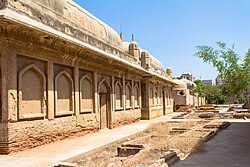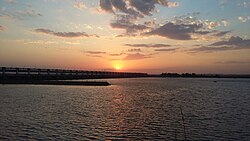Hyderabad District, Sindh
District of Sindh in Pakistan From Wikipedia, the free encyclopedia
Hyderabad district
| |
|---|---|
 Map of Sindh with Hyderabad District highlighted | |
| Country | Pakistan |
| Province | Sindh |
| Division | Hyderabad |
| Established | 1843 |
| Founded by | Government of India |
| Headquarters | Hyderabad |
| Government | |
| • Type | District Administration |
| • Deputy Commissioner | N/A |
| • District Police Officer | N/A |
| • District Health Officer | N/A |
| Area | |
| 1,740 km2 (670 sq mi) | |
| Population | |
| 2,432,540 | |
| • Density | 1,400/km2 (3,600/sq mi) |
| • Urban | 2,022,379 (83.14%) |
| • Rural | 410,161 |
| Literacy | |
| • Literacy rate |
|
| Time zone | UTC+5 (PKT) |
| Number of Tehsils | 4 |
| Website | www.hyderabad.gov.pk |
Hyderabad District (Sindhi: ضلعو حيدرآباد Urdu: ضلع حیدرآباد),ⓘ is a district of Sindh, Pakistan. Its capital is the city of Hyderabad. The district is the second most urbanized in Sindh, after Karachi, with 80% of its population residing in urban areas.[3]
History
The East India Company occupied Sindh in 1843. They formed three districts in Sindh administratively: Hyderabad, Karachi and Shikarpur.
In 1901, a new taluka named Nasrat was created from Sakrand and Shahdadpur talukas.[4]
In 1912, the northern side of the district separated to form Nawabshah district.[5]
In 1975, the southern side also separated to form Badin district.
After the 1998 census, two new talukas were created in the district named; Hyderabad city and Latifabad talukas.
After the 2002 elections, a new taluka was created in the district named Qasimabad from Hyderabad City taluka.
The city of Hyderabad is where the district headquarters were located and the district government used to be seated. The last Deputy Commissioner of the district was Rizwan Ahmed. Until the early 1970s the district included all the four districts mentioned above as well as the Badin district. This administrative setup was demolished by former President Pervez Musharraf in 2001 when he introduced the local body government.
In 2005, three new districts - Tando Muhammad Khan, Matiari and Tando Allahyar districts were formed out of Hyderabad district.[6]
Geography
Hyderabad District is 104,877 hectares in size.[7] 14,250 hectares of the district are under wheat cultivation, with a total annual production of over 55,000 tonnes.[7]
Administration and government
The district Administration is given below:
Demographics
Summarize
Perspective
| Year | Pop. | ±% p.a. |
|---|---|---|
| 1951 | 319,232 | — |
| 1961 | 537,000 | +5.34% |
| 1972 | 814,060 | +3.85% |
| 1981 | 1,005,460 | +2.37% |
| 1998 | 1,494,866 | +2.36% |
| 2017 | 2,199,928 | +2.05% |
| 2023 | 2,432,540 | +1.69% |
| Sources:[9] | ||
As of the 2023 census, Hyderabad district has 448,191 households and a population of 2,432,540.[10] The district has a sex ratio of 112.79 males to 100 females and a literacy rate of 67.21%: 70.86% for males and 63.08% for females.[1][11] 658,813 (27.08% of the surveyed population) are under 10 years of age.[12] 2,022,379 (83.14%) live in urban areas.[1]
Religion
| Religions in Hyderabad district (2023)[13] | ||||
|---|---|---|---|---|
| Religion | Percent | |||
| Islam | 90.67% | |||
| Hinduism | 8.32% | |||
| Christianity | 0.95% | |||
| Other | 0.06% | |||
The majority religion is Islam, with 90.67% of the population. Hinduism (including those from Scheduled Castes) is practiced by 8.32%, while Christianity is practiced by 0.95% of the population.[13]
| Religious group |
1941[14]: 52–53 | 2017[15] | 2023[13] | |||
|---|---|---|---|---|---|---|
| Pop. | % | Pop. | % | Pop. | % | |
| Hinduism |
115,015 | 53.51% | 180,926 | 8.22% | 202,368 | 8.32% |
| Islam |
97,762 | 45.48% | 1,998,896 | 90.86% | 2,205,523 | 90.67% |
| Sikhism |
1,587 | 0.74% | — | — | 75 | 0% |
| Christianity |
355 | 0.17% | 18,975 | 0.86% | 23,019 | 0.95% |
| Others [a] | 214 | 0.10% | 1,131 | 0.06% | 1,555 | 0.06% |
| Total Population | 214,933 | 100% | 2,199,928 | 100% | 2,432,540 | 100% |
| Note: 1941 census data is for Hyderabad taluk of Hyderabad District, which roughly corresponds to contemporary Hyderabad District. District and taluk borders have changed since 1961. | ||||||
| Religious group |
1872[16] | 1881[17] | 1891[18] | 1901[19] | 1911[20] | 1921[5] | 1931[21] | 1941[22] | |||||||||||
|---|---|---|---|---|---|---|---|---|---|---|---|---|---|---|---|---|---|---|---|
| Pop. | % | Pop. | % | Pop. | % | Pop. | % | Pop. | % | Pop. | % | Pop. | % | Pop. | % | ||||
| Islam |
558,272 | 77.33% | 594,485 | 78.78% | 713,000 | 77.61% | 744,632 | 75.29% | 781,219 | 75.32% | 411,776 | 71.81% | 460,920 | 69.53% | 507,620 | 66.9% | |||
| Hinduism |
163,222 | 22.61% | 159,515 | 21.14% | 204,785 | 22.29% | 242,692 | 24.54% | 246,008 | 23.72% | 160,211 | 27.94% | 198,684 | 29.97% | 245,849 | 32.4% | |||
| Christianity |
391 | 0.05% | 428 | 0.06% | 778 | 0.08% | 747 | 0.08% | 1,130 | 0.11% | 1,054 | 0.18% | 771 | 0.12% | 580 | 0.08% | |||
| Zoroastrianism |
45 | 0.01% | 21 | 0% | 46 | 0.01% | 89 | 0.01% | 96 | 0.01% | 57 | 0.01% | 31 | 0% | 30 | 0% | |||
| Judaism |
17 | 0% | 31 | 0% | 32 | 0% | 10 | 0% | 15 | 0% | 0 | 0% | 10 | 0% | 14 | 0% | |||
| Jainism |
— | — | 144 | 0.02% | 0 | 0% | 119 | 0.01% | 171 | 0.02% | 82 | 0.01% | 187 | 0.03% | 217 | 0.03% | |||
| Buddhism |
— | — | 0 | 0% | 0 | 0% | 0 | 0% | 0 | 0% | 0 | 0% | 0 | 0% | 0 | 0% | |||
| Sikhism |
— | — | — | — | 3 | 0% | — | — | 3,073 | 0.3% | 270 | 0.05% | 2,205 | 0.33% | 3,669 | 0.48% | |||
| Tribal | — | — | — | — | — | — | — | — | 5,432 | 0.52% | 0 | 0% | 0 | 0% | 769 | 0.1% | |||
| Others | 0 | 0% | 0 | 0% | 2 | 0% | 741 | 0.07% | 0 | 0% | 0 | 0% | 116 | 0.02% | 0 | 0% | |||
| Total population | 721,947 | 100% | 754,624 | 100% | 918,646 | 100% | 989,030 | 100% | 1,037,144 | 100% | 573,450 | 100% | 662,924 | 100% | 758,748 | 100% | |||
| Note1: British Sindh era district borders are not an exact match in the present-day due to various bifurcations to district borders — which since created new districts — throughout the region during the post-independence era that have taken into account population increases. Note2: Population decrease between 1911 and 1921 censuses due to bifurcation of district, and creation of Nawabshah District. | |||||||||||||||||||
Language
At the time of the 2023 census, 45.92% of the population spoke Urdu, 43.12% Sindhi, 3.12% Punjabi and 2.83% Pashto as their first language. The majority of Urdu speakers live in Hyderabad city and its suburbs, where they form a majority, while Sindhi dominates rural areas. Muhajirs arrived in Hyderabad after Partition.[23]
List of Dehs
The following is a list of Hyderabad District's dehs, organised by taluka:[24]
- Hyderabad Taluka (70 dehs)
- Abri
- Agheemani
- Almani
- Alni
- Amilpur
- Barechani
- Barham
- Bhido Jagar
- Bhido Rayati
- Bhinpur
- Bilori
- Bohiki
- Boochki Jagir
- Boochki Rayati
- Buxo laghari
- Chacha Detha
- Chukhi
- Dachrapur
- Dali Nandi
- Dali Wadi
- Damanchani Rayati
- Dhamanchani Jagir
- Ghaliyoon
- Ghotana
- Gujjan
- Gul Mohd Thoro
- Halepota
- Hatri
- Hotki
- Hussain Khan Thoro
- Kajhur
- Kathri
- Kathro
- Khanpota
- Khunjejani
- Kunner
- Lashari
- Liyar Jagir
- Mati
- Miyano
- Moharo
- Moolan
- Mori Jagir
- Mori Rayati
- Mulki
- Narejani
- Noorai Jagir
- Noorai Rayati
- Panhwari
- Pasaikhi
- Patbhari
- Patoro
- Raees
- Rahooki
- Rajpari
- Rukanpur
- Sahita
- Sanhwar
- Seri Jagir
- Seri Rayati
- Sipki Jagir
- Sipki Rayati
- Sukhpur
- Takio Jeewan Shah Jagir
- Takio Jeewan Shah Rayati
- Tando Fazal
- Tando Qaiser
- Thaheem
- Theba
- Widh
- Qasimabad Taluka (4 dehs)
- Jamshoro
- Mirzapur
- Sari
- Shah Bukhari
- Latifabad Taluka (10 dehs)
- Bora reyati
- Ganjo Takar
- Giddu Bandar
- Goondar
- Khater
- Lakhi Keti
- Malh
- Mehrani
- Met Khan
- Nareja
- Hyderabad City Taluka (4 dehs)
- Foujgah
- Ghanghra
- Gujjo
- Hyderabad
See also
Notes
- Including Jainism, Christianity, Buddhism, Zoroastrianism, Judaism, Ad-Dharmis, or not stated
- 1872 census: Also includes Tribals, Jains, Buddhists, and Nanakpanthis (Sikhs).
1881 census: Also includes Tribals and Nanakpanthis (Sikhs).
1891 census: Also includes Tribals.
1901 census: Also includes Tribals and Nanakpanthis (Sikhs).
References
Bibliography
Wikiwand - on
Seamless Wikipedia browsing. On steroids.


